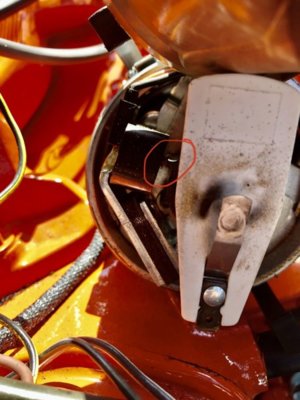Every carb I have worked on has a clear-flood mode. All you gotta do is open the primaries 100%. At the very end of the throttle-valve opening, a lever will open the choke at least a quarter inch, then you just crank it until it starts firing. It might start with just one plug firing,then three, then who knows but after several revolutions, it will begin trying to run; just keep cranking with the pedal on the floor. Well don't crank it forever,lol,sooner or later the starter might overheat and burn up. That's what they say but it's never happened to me .......
I have started dozens of cars this way since 1969. In fact I start my 1980 Volare slanty like this several times every summer when/if I have to move it. I actually splash a good ounce of gas straight into the carb throat. And my HO367 gets the same treatment every spring.
However;
there will come a point that if it hasn't started, then it won't because all the oil has been washed off the cylinder walls, and your ring-seal is too poor to help draw air into the chambers, and the cylinder pressure is too low to clear the plugs. For this reason I always use gas that I have already mixed oil into, for use by my weed-whacker/chainsaw. Works like a charm.
As for the reluctor gap, my testing shows a gap from zero to about .030 will reliably trigger the Factory ECUs, while .008 to .011 seems to be a good target if your top bushing is in good shape. Sometimes I have had to compensate for a bad bushing. It's just like points in that regard. The reason we use a brass feeler gauge, is because it's easier to "sense" the gap when magnetism isn't sucking it all together. I use whatever is handy, cuz it just ain't that critical. Rather, perhaps I should say; I've never found it to be critical.
As for float level; when it comes to starting; if the choke closes all the way then she hardly cares about float level. This is because an actual cold engine requires huge amounts of fuel to get going because a huge amount of that fuel will never take part in combustion, during the cranking period. Some of it is gonna puddle in the intake, some is gonna stick to the runner surfaces, and some of it is gonna pass straight thru the engine never having caught fire. And if you have a compression problem or the cylinders have been washed clean,then it's only gonna be worse. But as soon as she starts, well, all that fuel that that is hanging around in the intake, is gonna make it's way into the chambers and sometimes, almost all of it at once! So the fast idle is there to try to keep the engine running at this time. In a few seconds to a half-minute or so, the engine will clean itself out and the rpm may be a lil high; so this is when you " kick it down" a step on the fast-idle cam. Now the fuel-level becomes important. As does the choke pull-off adjustment. Depending on the ambient temp, and the condition of the carb-heating system, it should become possible at about the three-minute-mark, to kick the choke off. Now your low-speed system takes over.
But no; wet plugs no sparky;the electrode is shorted. Cracked insulators will often not spark either. Same with heavily sooted; and few coils will spark .080 gaps during cold-start. But .045 with a good coil is better than .035 with a crappy one..
















